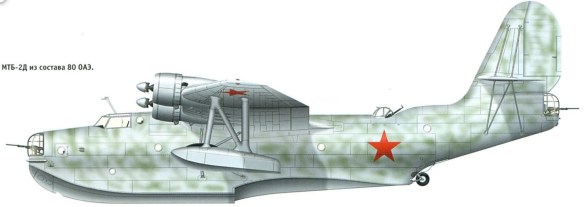Only two aircraft were built, the last one was destroyed in 1943.
In December 1934, Tupolev was asked to design a naval heavy bomber (Morksoi Torpedonosets Bombardirovshik = naval torpedo bomber = MTB). With his seaplane specialist Ivan Pogosski dead, he gave the project to Aleksander Golubkov who came up with a more conventional design than the earlier ANT ‘hydroplanes’ – a single hull with a high-wing profile, made entirely from duraluminium. It was an amphibian with a retractable wheeled undercarriage, and the floats, mounted near the wingtips on struts, were load-carrying. Powerplants were four Gnome Rhône 14Krsds, which gave 810hp each, and were conventionally mounted in the wing leading edges. The wings’ shape resulted in the ANT-44, as the project was designated, being called the Chaika (Seagull).
Construction of the prototype began on 4 October 1935, and the aircraft was manufactured with smooth sheets of duraluminium, which were now becoming available in place of the former corrugated ones. The work was carried out in the TsAGI-ZOK factory N156. It was completed in March 1937, and brought by road to Khodinka, from where it made its first flight on a fixed wheeled undercarriage (because the retractable mechanisation was not yet ready) on 19 April 1937. Its pilot was Timofei Riabenko. State tests were conducted with the undercarriage fixed down; maximum speed was measured at 355kph/221mph, maximum take-off weight at 18,500kg/40,7921b, and range with a bomb or torpedo load of 2,500kg/5,5121b was 2,500km/l, 554 miles. The state tests were completed in July.
A second aircraft was completed in June 1938; by now, the first had its undercarriage modified to retract, while the second aircraft had a retractable one from the start. It had 840hp Mikulin M-87As fitted and was dubbed the ANT-44bis or -44D.
By September, both aircraft were taken on service with the Soviet Navy, as the MTB-2A. No production was ordered, and they served some operations in the Great Patriotic War from bases in the Black Sea. Led by Ivan Sukhomlin, the MTB-2As were used to bomb oil refineries in Bulgaria and Romania, both then under Nazi occupation. But before the Soviet Union was invaded by Germany, Ivan Sukhomlin had earned four world records, with the ANT-44bis. In June 1940, he set several records lifting different loads to record altitudes for amphibians, and on 7 October he achieved a record for amphibians by carrying a two-tonne load over a 1,000km/621 mile closed circuit at an average speed of 241.999kph/150.378mph. Although this record was not acknowledged by the FAI until after the war, it stood unbeaten until 1957.
